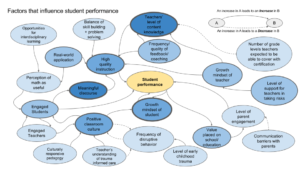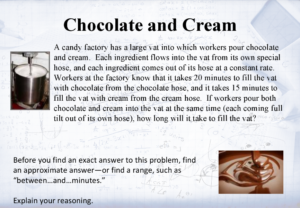Our discussion at February’s Collab Lab focused on engaging families. As we explored goals we have for family engagement we considered: Who we include as “family” in “family engagement” Who family engages with Where/When it happens Who benefits/how While parents, siblings, and caregivers of students are obvious starting points for who to include as family, the discussion quickly broadened to include a much broader group. The extended families of students, individuals and families in the community which surrounds a school, those who may work or own businesses in the community around the school. In no small part, this expansive view family reflects a deeper goal — that the school is not simply a place where students and teachers spend the day, but that it is deeply embedded in the life of the community. This broader approach to engagement changes the way one thinks about who the school and it’s families engage with. It’s not just about caregivers connecting with their student’s teachers. It’s about giving those families a chance to connect with each other, individuals and organizations who support their school, and in particular. It looks to move past one way communication, simple reporting out of what a school thinks families ought to know. It looks to build the relationships and trust that allow disengaged families to engage and for the community to come together not just to support the work of students and their families, but to support each other. It changes as well, where engagement might take place. It moves beyond family coming to school. It’s the school coming out into the community. This expansive view of engagement only works if all participants see benefits, and they see that their contributions to the school community, as students, teachers, family members or neighbors are valued. What do members of the school community need to engage? As we moved the discussion to what’s needed to engage, the word “dignity” came up early. Again, not just dignity for caregivers, but dignity for students, teachers, and members of the broader community who schools do or seek to engage with. For caregivers, this means recognizing both the time, financial, and other constraints and obligations they work face, but that they have something to of value to offer, that they are partners in the education of their child. Often it comes down to the simple things– if we are asking for something more of any of the participants, what burdens can we remove? A time that works for those we want to engage with Providing food at events that may overlap with meal times Helping with transportation Activities for children that may need to come when a caregiver is there for an adult conversation Most importantly, don’t waste someone’s time. This means not asking teachers, caregivers, or members of the broader community to participate in engagement activities they don’t value or benefit from. The process starts with how we invite the engagement. Are we asking for engagement because we see a caregiver or a student as a problem or the one that needs to solve it, or are we asking for engagement to work together for a better outcome. In the end, it comes down to recognizing that members of the broadly defined school community each come with a different set of goals. Effective engagement doesn’t mean that everyone needs to share the same set of goals. It requires that we acknowledge the goals they do have, understand where they align, and find something useful to work on together that allows everyone to come out ahead. It’s how trust is built. A special thanks to our featured guests, Amber DuChateau — Art Teacher at the Milwaukee Academy of Science Aubrey (Ellickson) Fulsaas — Environmental Educator, Schlitz Audubon Nature Center Bernie Traversari — Director of Operations and Programs, Society for Conservation Biology North America & STEM Education Consultant Additional thanks to Bernie for his help facilitating the session. Bernie joined us to record a debrief of the session that you can find on inspirEd. As always, we’re appreciative of MSOE for letting us make use of the NM Lab in the WE Energies STEM Center every month. Up Next Collab Lab 67: Connecting to Community Thursday March 13th, 5:30 to 8:30 pm at MSOE’s STEM Center Actively using some form of PBL with your students and looking for ideas or encouragement from others? Consider joining your peers in the inspirED Community.

 For the bulk of the evening, Kevin McLeod from UWM’s Department of Mathematical Sciences led the group through a discourse session on a single math problem appropriate for middle school students. This helped provide context for the higher level conversation which ran in parallel around the reasoning behind the process. The problem and his notes are available to download here.
For the bulk of the evening, Kevin McLeod from UWM’s Department of Mathematical Sciences led the group through a discourse session on a single math problem appropriate for middle school students. This helped provide context for the higher level conversation which ran in parallel around the reasoning behind the process. The problem and his notes are available to download here.
